SUMMARY
This is AI generated summarization, which may have errors. For context, always refer to the full article.

The volume of food a family consumes depends on the amount of food they purchase given the resources available to the family. The level of food consumption of a family is undoubtedly influenced by prevailing commodity prices in the market.
Using first semester income data from the 2012 Family Income and Expenditure Survey conducted by the National Statistics Office, the National Statistical Coordination Board (NSCB) estimates that in the first semester of 2012, about one out of 10 Filipino families was “food poor.” That is, 10% of families in the first 6 months of 2012 had incomes not sufficient to meet the minimum basic food needs.
This figure is unchanged from the corresponding figures in the first semesters of 2006 and 2009. See Table 1.
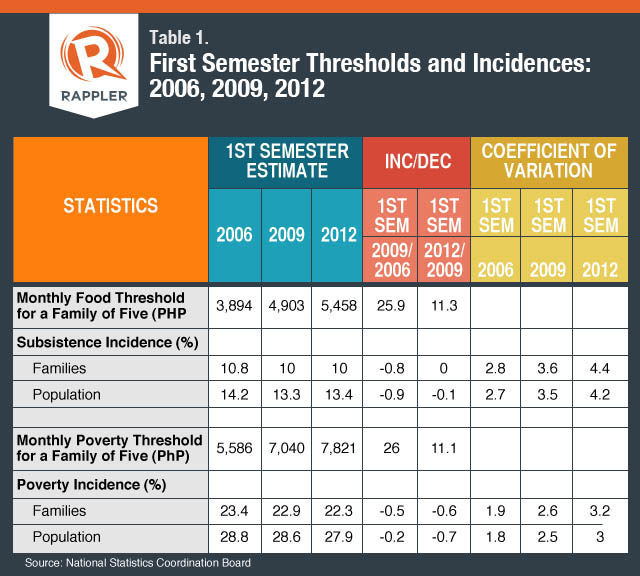
In the first 6 months of 2012, Filipinos needed at least an income of P5,458 for a family of 5 per month for them not to be considered as food poor.
Relatedly, as prices of basic goods and services increase, these “food poor” families will continue to face difficulties especially in meeting their basic food needs. Many people are under the impression that it is the responsibility of government to maintain inflation.
Actually, this task to promote a low and stable inflation is the objective of monetary authorities of the country, chiefly the Bangko Sentral ng Pilipinas (BSP). The BSP has been adopting an inflation targeting framework for monetary policy to stabilize prices deemed conducive for a balanced and sustainable economic growth.
Consumer price index
The changes in the price level of goods and services that most people buy for their day-to-day consumption is measured by the Consumer Price Index (CPI). This indicator is used by the country to measure the rate of inflation, which is equivalent to a decline in the purchasing power of peso.
Since families that belong to the lower portion of the income distribution are more susceptible to economic and social downturns (than those in the higher brackets), monitoring the welfare of these families is one of the main thrusts of government.
The National Statistics Office (NSO) reports a separate CPI for the bottom 30% income households based on a concept of “relative poverty.” One of the common patterns in this income group is that the amount of money spent on food items is substantially higher compared to their expenditure on other items (see table 2 below).
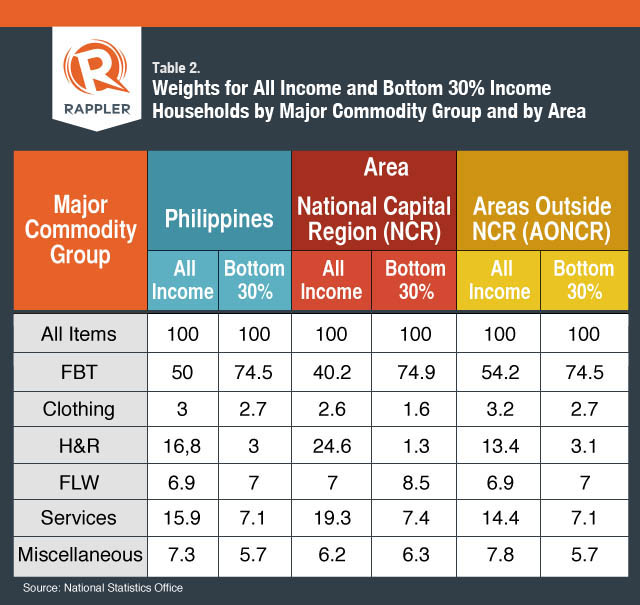
This is consistent with Engel’s law, which states that as income rises, the proportion of income spent on food falls, even if actual expenditure on food rises. Thus, price changes in food items significantly affect families in the low-income group than any other group (e.g. middle or upper income).
The CPI for the bottom 30% income households, therefore, can provide a more appropriate deflator of income and inflator of food prices and other basic commodities, which can be used by the government in making plans and programs to uplift the standard of living of low-income families.
Inflation and safety nets
Over the past decade, the average rate of inflation for the bottom 30% income households was recorded at 5.7%. This inflation rate is higher than the inflation rate for all income groups (4.6%). Note that in 2008, when the global financial crisis commenced, the recorded inflation rate for the bottom 30% was 13.9%.
Expectedly, the significant increase in inflation rate for the bottom 30% income households in 2008 was attributed to the food component of the CPI which surged to 17% during the year. (See Tables 3 and 4.)
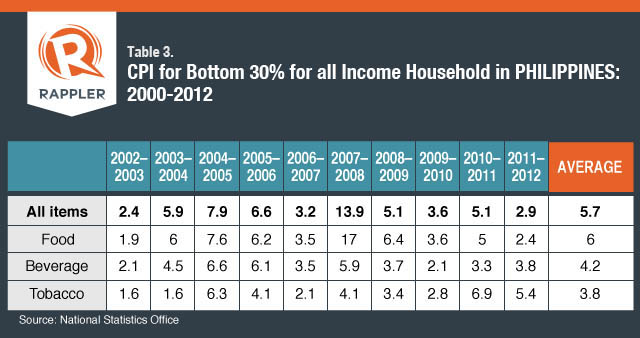
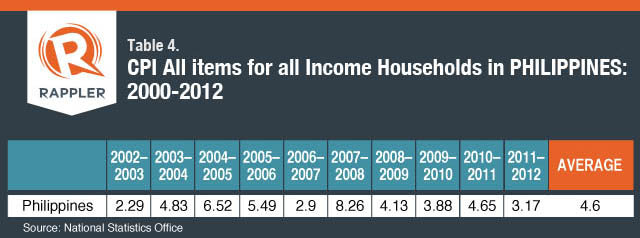
This illustrates that in the midst of economic crisis, the low-income earners, who have relatively higher expenditure share allotted on food, are adversely affected. Consequently, it is important for government to ensure that social safety nets are present (but we must also remember that safety nets are meant to be transitory in nature).
What are the foods commonly consumed by Filipinos who belong to the bottom 30%?
In 2012, the NSCB published “Sexy Statistics” articles entitled, “Where can you buy the cheapest Bangus, Galunggong and Tilapia?” and “Sulu sells the cheapest rice” to provide the public information on relative price levels of basic food that Filipinos typically serve in their tables.
The retail price of regular milled rice, the staple food of Pinoys, has practically doubled over a dozen years, from P18 per kilo in 2000 to P32.1 per kilo in 2012. In 2012, rice was most expensive in Iloilo, followed by Mountain Province and Siquijor. Surprisingly, the Rice Granary of the Philippines, Nueva Ecija, is not offering the most affordable rice; instead, Quezon, Tarlac and Nueva Vizcaya have the cheapest rice (see Tables 5-7 below).
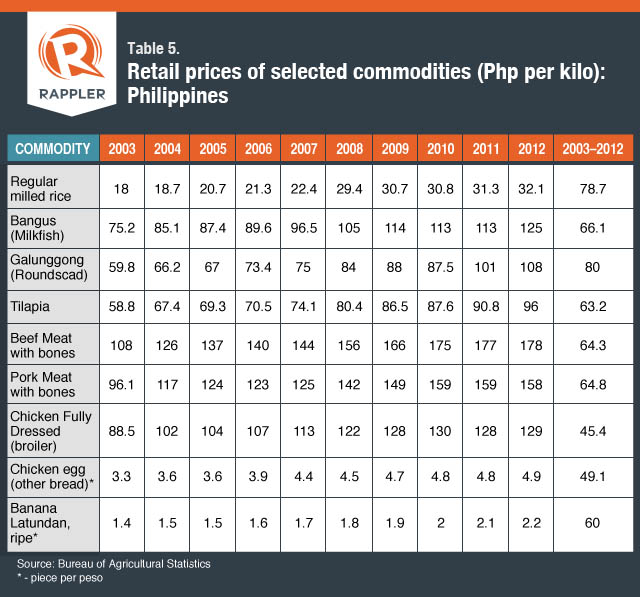
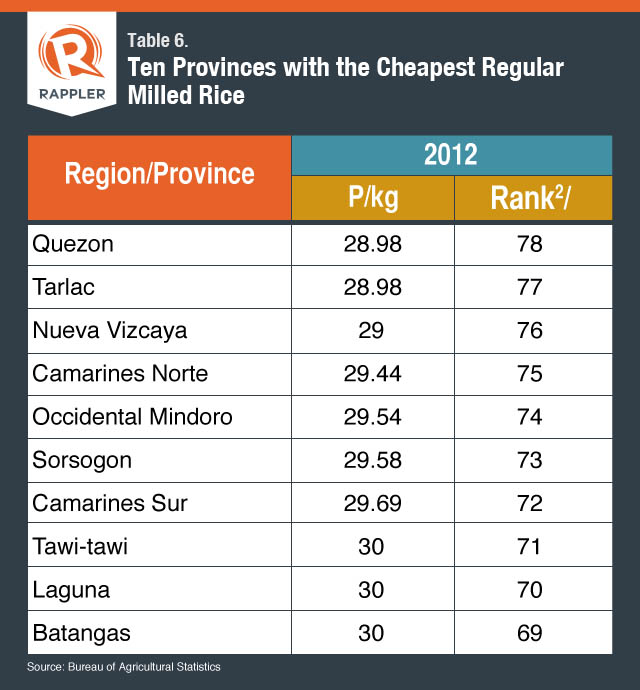
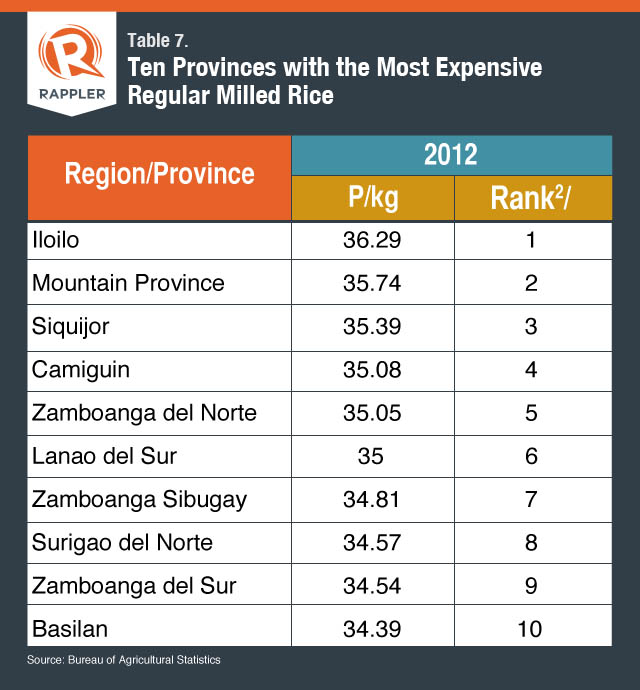
Fish commonly served by Filipinos, viz., bangus, galunggong and tilapia, have dramatically increased their prices. Before, galunggong or “GG” used to be the “poor man’s fish,” but there are clear signs that this is not true anymore.
GG retail price increased from P59.8 per kilo in 2003 to P107.7 per kilo in 2012 or by 80%. The most expensive GG can be found in Mountain Province, Rizal and Cavite. However, you can still find the cheapest GG in Davao del Sur, Occidental Mindoro and Marinduque (see Tables 5, 20, 21).

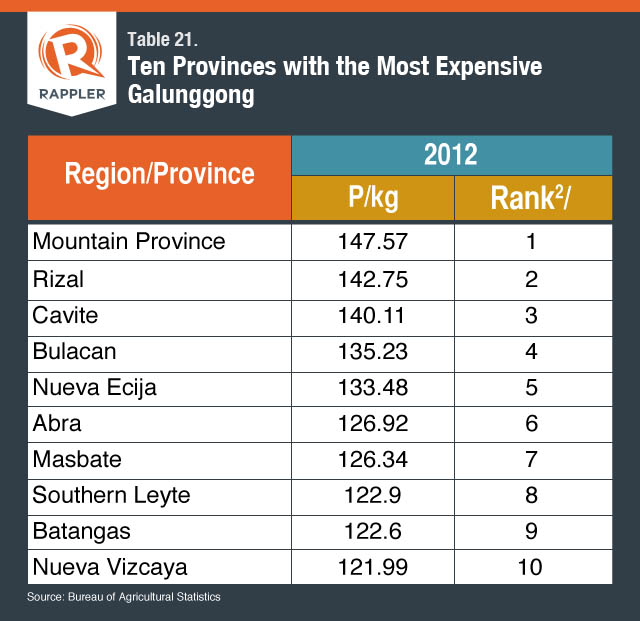
The prices of tilapia and bangus also increased by 63.8% and 53.5%, respectively (see Table 5).
Meat prices
Over the years, beef and pork meat with bones relatively increased their retail price. The beef meat with bones retail price increased by 64.3% in 2012 compared to 2003. Likewise, the price of pork meat with bones increased by 64.8% in 2012 (Table 5). Among provinces, the most expensive are in Bataan while the cheapest beef and pork meat with bones can be purchased in Sulu. (See Tables 10-13)
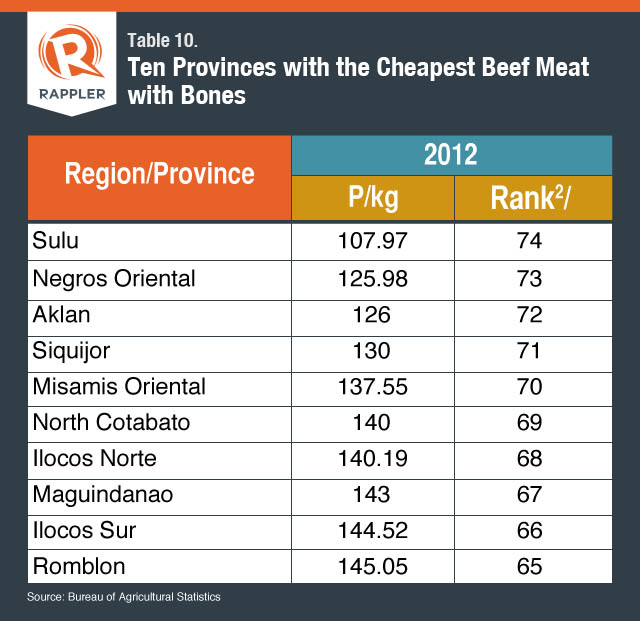
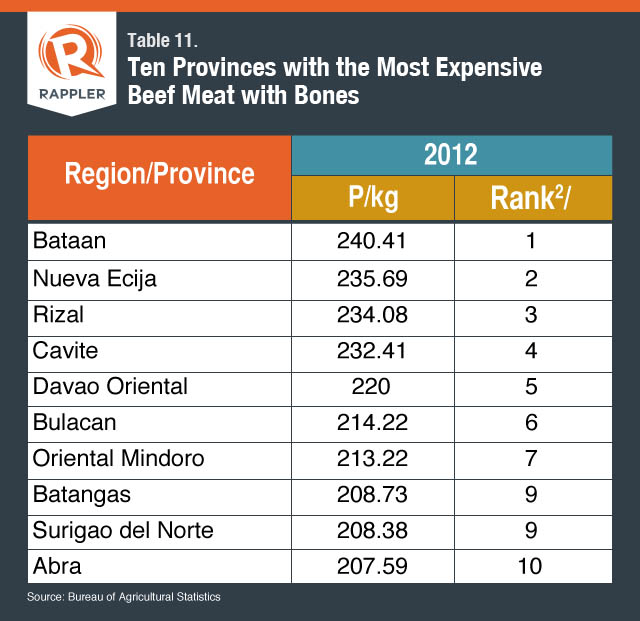


To those who go on banana diets, you may want to note that the most expensive bananas are in Bulacan, Nueva Ecija and Benguet, while the most affordable banana latundan can be found in North Cotabato, Davao Oriental, and Sultan Kudarat. (See Tables 8 and 9)
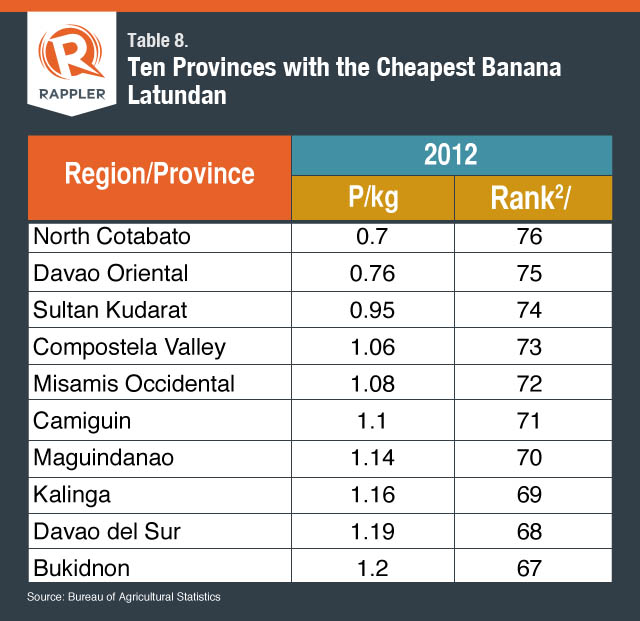

Similar to the findings of the abovementioned articles, subsistence incidence has a significant positive correlation with the retail price of regular milled rice for the first semester of 2012 (see Table 23).

As proclaimed by President PNoy, 2013 is the National Year of Rice. This campaign advocates for responsible rice consumption to achieve rice-self-sufficiency starting 2013. As part of this advocacy, we are even encouraged to recite the “Panatang Makapalay:”
“Bilang isang mamamayang Pilipino nakikiisa ako sa panatang huwag magsayang ng kanin at bigas. Magsasaing ako ng sapat lamang at sisiguraduhing tama ang pagkakaluto nito. Kukuha ako ng kaya kong ubusin upang sa aking pinggan ay walang matirang kanin. Ganun din ang aking gagawin kung may handaan o kung sa labas ako kakain. Ang brown rice o pinawa ay susubukan kong kainin pati na ang ibang pagkain bukod sa kanin tulad ng saba, kamote, at mais. Ituturo ko sa iba ang responsableng pagkonsumo nang mabigyang halaga ang pagod ng mga magsasaka at nang makatulong na maging sapat ang bigas sa Pilipinas. Aking isasapuso ang panatang ito dahil sa bawa’t butil ng bigas o kanin na aking matitipid ay may buhay na masasagip.”
However, we don’t want to be rice-sufficient only but we must make rice affordable especially to the poor. In the past, government sought to do that by having the National Food Authority (NFA) rice sold at prices lower than the regular retail price of other kinds of rice.
Unfortunately, data from the FIES suggests that there is leakage in access to NFA rice among non-poor households (because of lack of targeting mechanisms for the poor). Currently, the government has embarked on having a registry of poor households (through the Department of Social Welfare and Development’s National Household Targeting System) as well as a registry of farmers (through the Department of Budget and Management’s Registry System of Basic Sectors in Agriculture).
Such targeting systems can help minimize leakages in interventions.
Are the efforts of the government towards achieving low and stable inflation enough to combat volatilities in the global economy?
Based on our Quarterly Economic Index (QEI) report, the compensation per employee index, which includes salaries and wages received by employees in cash and in kind, increased by 8% in the 4th quarter of 2012 from 4.7% in the same quarter of the previous year. It is no wonder why recent statistics collected by the private sector suggests more optimism among Filipinos.
The monetary authorities have sought to put in place various monetary measures to stabilize prices. Price stability is essential in reducing poverty and in sustaining economic growth. The prices of basic commodities directly impact the capability of people, especially poor families, to purchase basic food commodities. Along with the initiative of the BSP towards stabilizing inflation rate, the minimum wages are regularly reviewed by the Regional Wage Boards of the Department of Labor and Employment as an additional social protection mechanism.
These interventions seek to assist those at the lower income distribution. In addition, government is now taking on the challenge of having more interventions to ensure inclusive growth and development. But at the end of the day, government should never be alone in its development work.
The private sector has to do its share of development work. While the private sector is driven by the goal of making profits, it must also remember that it lives in a larger community, and this goal of making profits must be balanced with a sense of corporate social responsibility. – Rappler.com
This piece is part of the NSCB’s “Beyond the numbers” series that comes out every second Friday of the month. It was co-written by Priscille C. Villanueva and Mai Lin C. Villaruel.
Reactions and views are welcome thru email to the author at jrg.albert@nscb.gov.ph. Dr Albert is NSCB secretary general. See more at: http://www.nscb.gov.ph/beyondthenumbers/2013/07122013_jrga_price.asp#sthash.8Ag7OKuu.dpuf
Add a comment
How does this make you feel?
There are no comments yet. Add your comment to start the conversation.